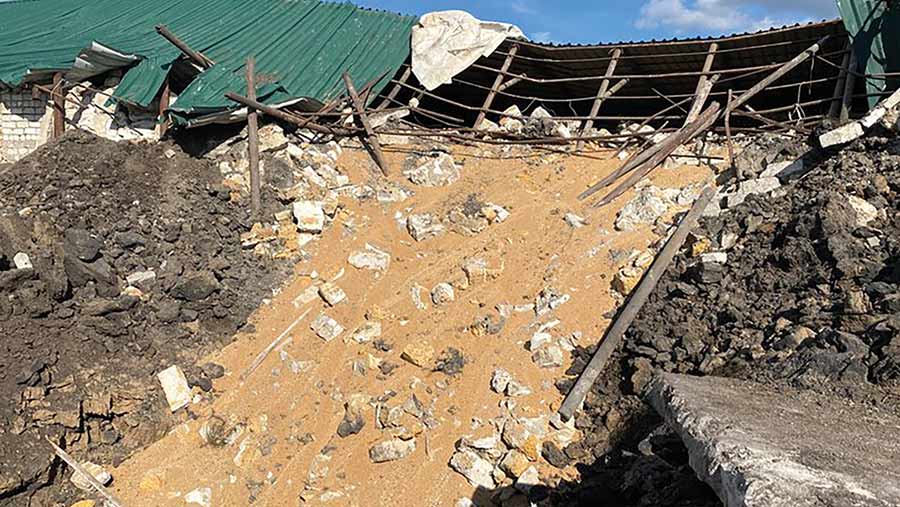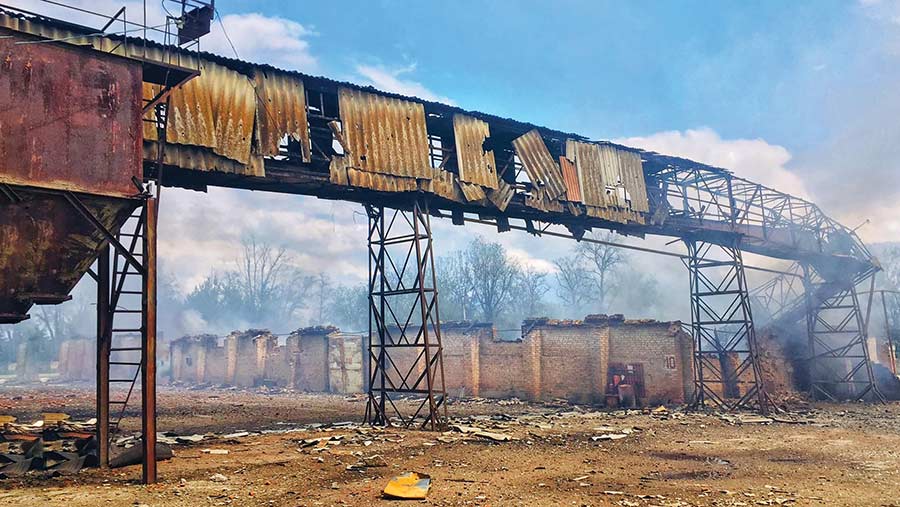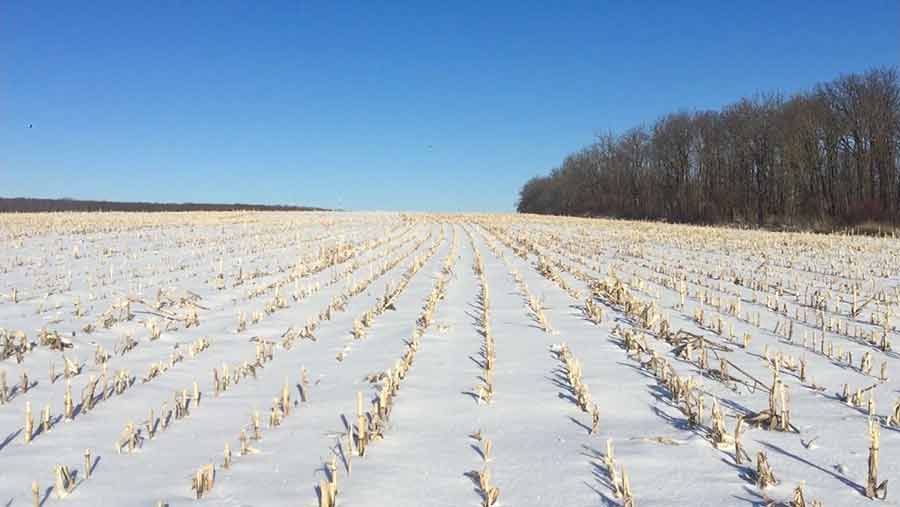Ukraine war: Farmers fight for survival two years on
 © Sopa Images Limited/Alamy
© Sopa Images Limited/Alamy This weekend marks two years since Russia’s full-scale invasion of Ukraine began, leading to skyrocketing food and energy prices and exacerbating global food security challenges.
Ukraine has been dubbed the “breadbasket of the world” for its abundant production of wheat, barley, maize, soya beans and sunflower oil, thanks to its remarkably fertile black “chernozem” soils. But its agriculture sector has been turned upside down by Russia’s invasion.
The country plays a massive role in providing food for the world and feeding families in Asia and Africa.
See also: Video: Farm pickups take emotional journey to Ukraine war
Its main agricultural exports are wheat, maize and barley, which are shipped to markets as far away as China, Indonesia, Turkey and Egypt.
Since war began on 24 February 2022, many thousands of Ukrainian farmers have enlisted with the Ukrainian Army to fight against the Russian invaders.
Those with machinery driving skills are of particular value as these are transferable to drive tanks.

© Ukrainian Agribusiness CLub
Losses double
Compared with February 2023 estimates, the losses to Ukraine’s agricultural industry have more than doubled.
The damage and losses suffered by farmers are estimated to amount to US$80.1bn (£63.6bn), according to the World Bank’s third Rapid Damage and Needs Assessment report (PDF), published on 14 February.
The report estimates that even if hostilities were to stop now, it could take 20 years for Ukraine’s agriculture sector to recover to pre-war conditions. But with every passing month and year, this period is extending.
Ukraine’s minister of agrarian policy and food, Mykola Solskyi, tells Farmers Weekly that since the start of war, Ukraine has lost 20% of its farmland – an area equivalent to the size of Lithuania or Hungary.
More than two million Russian mines are thought to be strewn across fields, covering all territories.
In total, about four million hectares of farmland is currently unusable due to mines, contamination with explosive remnants, or ongoing hostilities, Mr Solskyi says. Demining could take decades before land can be farmed again.

Orikhovskiy elevator © Ukrainian Agribusiness- Club
Blockade of ports
Over the past two years, Russia’s blocking and bombing of Ukrainian ports in the Black Sea and Sea of Azov has caused significant problems, damaging grain silos, infrastructure and choking off exports of wheat and other commodities.
During the early months of war, the blockade of the Black Sea caused a sharp fall in agricultural exports.
Prices for Ukrainian wheat and maize slumped by 45% between January and June 2022, while global prices increased by 15%.
The Black Sea Grain Initiative, launched in July 2022, increased exports. However, Russia walked away from the deal in August 2023, causing export volumes and local farmgate prices to fall again.
But the Ukrainian agriculture ministry reports that grain exports out of the Black Sea are broadly back to pre-war levels.
Odessa port is exporting even more than before the full-scale invasion, which compensates for the ports in the region of Mykolaiv being out of action.
In December, Ukraine exported seven million tonnes of cargo through the Black Sea ports, including almost five million tonnes of agricultural products.
For farmers in 90% of Ukraine’s territory, it is now more profitable to transport grain to ports than across the border with Poland, Hungary or Slovakia.
“We hope the situation will stay the same. We are doing everything to ensure that this export route remains the main one for Ukrainian farmers,” Mr Solskyi says.
Analyst Mike Lee, founder and owner of Green Square Agro Consulting, which specialises in forecasting Black Sea grains, says early indications are quite positive that the new Ukrainian corridor is working well.
But he adds: “Given the circumstances, it’s a relatively fragile situation and it wouldn’t take much for something to set this back.”
2023 harvest and outlook
Favourable weather last year in Ukraine helped a recovery in grain and oilseeds production (to 79m tonnes), but this remained below the 2021 level of 105m tonnes. For 2024, total crop output is forecast at about 65m tonnes.
The 2023 maize harvest is predicted to total 30.5m tonnes, but 10% of the crop remains unharvested.
There are concerns some of this area will now not be harvested due to low prices and farmer cashflow issues, as well as the added cost of harvesting.
The 2023 Ukraine wheat harvest totalled a provisional 22.5m tonnes, which would give a record average yield of 4.79t/ha, well above the preceding five-year average of 4.01t/ha.
Mr Lee says: “Farmers planted the crops and applied inputs, but the rainfall really boosted yields. That gave the 22.5m-tonne crop.”
The conditions and rainfall so far for the 2024 growing season suggest another very reasonable yield for wheat (95-96% of wheat grown in Ukraine is winter wheat), he adds.
But the wheat area has declined again, with an overall projection of 19-20m tonnes, according to Mr Lee’s extensive work.
In 2024, soya bean and sugar beet plantings are expected to increase, up 21% and 17%, respectively, on 2023 levels.
But the area of maize grown will decrease by 9%, according to a survey of farmers’ spring planting intentions conducted by the Ministry of Agrarian Policy and Food of Ukraine.
Pulses also remain a priority, with planted area increasing by 11%, and spring barley by 7%. Growing interest in barley may be due to the expansion of the geography of sea shipments. Spring wheat plantings will increase by 2%.
Farmers are interested in growing spring oilseed rape. Some producers plan to sow rapeseed for the first time. In general, the area under this crop will increase by 24%.
The area under sunflowers could, as a consequence, be reduced. However, as of today, most farmers have not yet made a final decision on the planted areas of this crop.
In 2024, the overall area under spring crops may decrease by 0.5m hectares, or 3.7%, compared with last season.
Olga Trofimtseva, ex-acting minister of agrarian policy and food, says the 2024 sowing campaign is already underway in some regions – for example, in Mykolaiv, southern Ukraine.
“Farmers are sowing, but they are changing their production structures. This season, some large farming companies will not sow grain maize, and will shift their cropping to niche crops such as buckwheat and millet,” she explains.
“This is because, in some cases, growing these ‘magic’ commodities, such as wheat, maize and barley, are not profitable. Last season, we saw a shift towards oilseed rape and soya beans.
“This trends looks set to continue in 2024.”

© Mike Lee/Green Square Agro Consulting
Ukrainian grain export protests
Farmers in central and eastern Europe have led protests because of the effect of Ukrainian grain imports, which they claim are undercutting their domestic grain production.
Protests have taken place in Bulgaria, Romania and Poland, where farmers and truck drivers have blocked border crossings with Ukraine.
Many farmer protesters have blamed the EU for allowing Ukrainian food imports to remain free of duties until at least June 2025.
On 11 February, Polish farmers pried open Ukrainian trucks crossing into Poland and spilled grain onto the road.
Ukraine’s agriculture ministry condemned the “destruction” of its grain and the Ukrainian Agri Council called for “an immediate stop to such radical actions”.
Andriy Dykun, head of the Ukrainian Agri Council, said Ukraine exports no more than 300,000t of products through western borders, with the majority exported via the sea corridor.
“If such small volumes cause indignation, the question arises as to why the same indignation does not arise in relation to another country that sells much larger volumes to Poland?” he asks.
Polish farming minister Czeslaw Siekierski condemned the incident as “not the right type of protest”, but said it highlighted the plight of Polish farmers.
Call for solidarity
Oleksandra Avramenko, director of the European Integration Committee of the Ukrainian Agribusiness Club, says Ukrainian farmers are facing losses for the third year running.
“Farmers face losses every time. They can’t sell properly on the internal market, which has a surplus of products.
“The price to get your product from the field to the silo is already lower than your cost of production,” she explains.
“Right now, the sea corridor is working. This is the only hope for the sector to survive.
“Some farmers have found customers in Europe, or they produce under the European standards and they export through Europe. But then they face protests on the border.”
Ms Avramenko says Ukrainian farmers do not have enough cashflow and have fewer opportunities to sell their goods. Many are getting by with government loans, which will need repaying.
“Ukrainian farmers are in a trap and fighting to survive. If you stop producing, stop sowing [crops] even with reduced land, you die,” she adds.
Ms Avramenko says farmers are trying to operate as normally as they can by exporting millions of tonnes of grain each month through the sea corridor.
The quality of their produce is high, even more so as they are using fewer chemicals, she adds.
“Ukrainian farmers are in a deep, terrible situation. We don’t want to deliberately destroy internal markets, but farmers need to sell some of their produce by land to survive and get some funds,” she says.
“We expect solidarity and understanding, not protests at the border which create problems, not just for farmers, but also for the whole economy.”
Farmers are fighting to stay afloat, says southern grower
Ukrainian farmers are basically farming to survive, not to make profit, says one farmer based in southern Ukraine.
Since the war started, cashflow has worsened for farmers and almost 70% of transactions are made with cash, adds the farmer.
The weather has been favourable and after some good snow and rain this winter, yield prospects are looking positive for now, he says.
Labour issues are becoming more acute, and mobilisation has increased the shortage of farmworkers.
Logistics are working more or less OK but are expensive, eating into a big part of the margin, says the farmer.
Although export prices are down, freight and domestic logistic costs are not falling, “so again, it’s the farmer who pays”.
